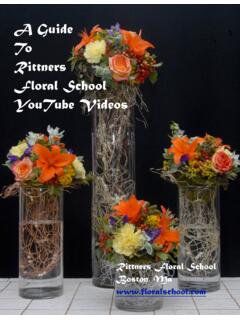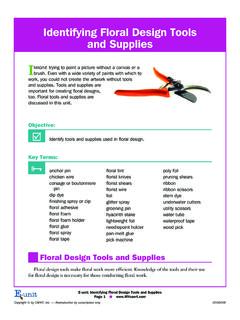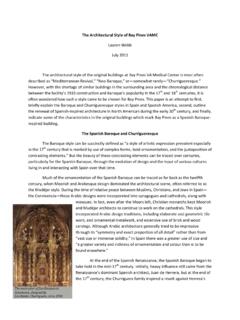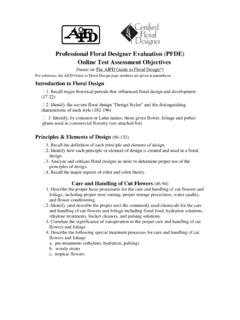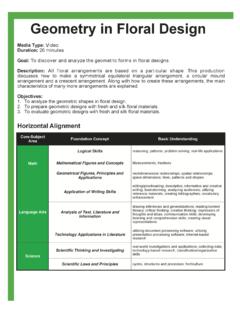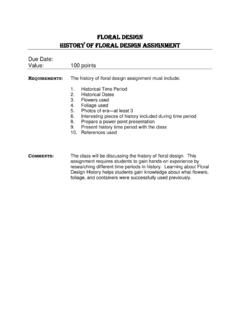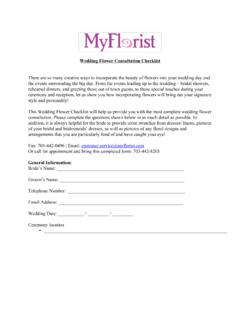Transcription of Principles of Floral Arrangement - University of Tennessee
1 Principles of Floral Arrangement This publication has been prepared by the Baxter County Master Gardeners as an introduction to Floral Arrangement for use in exhibiting at the Baxter County Fair 2 Introduction Floral Arrangement is the art of selecting and organizing flowers and foliage according to the elements and Principles of design in order to attain a pleasing and interesting design . Arranging flowers is an artistic activity and a way to express oneself creatively; county fairs offer the flower arranger an opportunity to participate in this art form. The following information is offered as an introduction to the basic Principles of Floral Arrangement . This publication does not address Baxter County Fair exhibiting rules and requirements. For fair rules and requirements for exhibiting Floral arrangements, see the Baxter County Fair Book and the Baxter County Master Gardener publication Exhibiting Flowers and Plants.
2 Both publications are available at the Baxter County Cooperative Extension Service, 213 East 6th Street, Suite 111, Mountain Home, AR 72653, (870) 425-2335. 3 Principles of Floral Arrangement Materials Cutting Flowers and Foliage Successful Floral Arrangement begins with fresh plant materials that have been properly handled and prepared. Beauty and good composition of an Arrangement is not determined by the cost or rarity of plant materials used, but by the way they are selected, cared for and arranged. Cut flowers and foliage the evening before the Arrangement will be made to allow time for proper conditioning. Handle plant material carefully, handling only the stems. Most flowers will keep best if cut when nearly fully open. Many tight buds or young leaves wilt rapidly and will not take up water. Some flowers will keep best if cut in the bud stage or when they are just beginning to open.
3 Fully open or faded flowers are past prime and usually will not keep well. Experiment with various types of plant materials to determine the best stage of maturity for cutting. Cut flowers and foliage with a sharp knife or flower shears. Cut stems on a slant to enable flowers to absorb more water. Cut stems longer than required for Arrangement . Cut extra stems in case of damage. Stand flowers and foliage in a bucket of cool water as they are cut from the garden; place indoors in a cool, dark place. Re-cut stems indoors at a 45-degree angle. Cut stems under water to prevent air from entering the stem and interfering with water uptake. Place only an inch or so of the stem under the water to cut it. Conditioning Plant Materials Conditioning is an important factor in successfully arranging and exhibiting cut plant materials. The purpose of conditioning is to allow the cut plant material to absorb as much water as possible.
4 Plant material that is not conditioned appears dried out or wilted. Do not attempt to arrange flowers that have not first been properly conditioned; plant material that has not been conditioned is easily damaged in the Arrangement process. Proper conditioning will also prolong the life of the Arrangement . Stand cut plant materials in lukewarm water to a depth of half their length overnight in a cool, dark place. This allows the stem, leaves, and blossoms to absorb water to enable them to retain optimum beauty. The next morning, cut stems again under water at a 45-degree angle. Remove all foliage below the water level of the container; submerged foliage decays, creating foul water. Leave the cut plant materials in water until ready to use them. Wait until the plant materials feel stiff before arranging them. Some flowers with fleshy, fibrous stems such as cockscombs or sunflowers will last longer if about inch of their cut ends are dipped in boiling water before being placed in a container.
5 Woody stems should be peeled back and split to allow the stem to absorb more water. Plants that exude a milky substance should be sealed by searing the cut end, using a flame or by dipping it into powdered alum. Hollow-stemmed flowers should be filled with water before being placed in a container. Holding the cut flower upside down, fill the stems with water, invert the flower holding a finger over the cut end of the stem, place in water. Some plant material (generally foliage) will benefit from complete submersion in lukewarm water overnight. Experiment with different approaches to conditioning the flowers and foliage to be displayed to determine the best method. This will also help determine which flowers are well-suited for exhibiting. 4 Containers The container should have been thoroughly washed since its last use. Fill the container with water before beginning to arrange the plant material.
6 The size of the container should be in scale with the table or location where it will be used. Remember that the larger the container, the more plant material will be needed. Suit the shape of the container to the Arrangement to be made. Simple shapes are easiest to work with. Avoid ornate containers as they may detract from the Floral Arrangement . Neutral colors like tan, brown, gray or greens are easy colors to harmonize with plant materials and with most backgrounds. White can be very stark and call attention to the container rather than to the Arrangement . Colored containers are available, but should be used with care so as not to detract from the Arrangement . Containers come in many materials, such as glass, pottery clay, porcelain and metal. Clear glass containers are generally undesirable as the stems are visible. Containers can be thin and dainty, or thick and sturdy.
7 The spirit of the Arrangement and the container should go together. For example, an Arrangement of miniature roses would be more suited to a delicate silver vase than a bulky clay bean pot. Holders A good holder should give the freedom to position stems where they are wanted and hold them in place securely. Choose a holder suitable for the style of Arrangement planned, the plant materials to be used and the container to be used. Pinpoint Holders Pinpoint holders are most often used for line and line-mass arrangements in low bowls or shallow containers. Use a waterproof Floral clay to fasten the holder to the base of the container. A heavy metal pinpoint holder is easiest to keep in place in the container. Stems are either stuck directly onto the pins or are wedged between the pins. Thin stems may be placed on a pinpoint holder by binding several stems together with a rubber band, string or Floral tape.
8 5 Floral Foams Wet Floral foams such as Oasis brand hold stems in place and supply water to the flowers. Floral foams are available in wet or dry forms; wet foams are used for arranging fresh plant materials, while dry Floral foam is used for dried or silk Floral arrangements. Wet and dry types of Floral foams are not interchangeable their intended use is specific. Wet Floral foam should not be reused because existing holes in the foam will not supply water to the stems of plant materials. Floral foam is inexpensive and may be purchased from Floral supply stores, arts & crafts stores or florists. Floral foam is best used for line-mass or mass arrangements, but may be used in some line arrangements also. Before use, soak the foam in a pail of water until it barely floats. A clear Floral preservative should be added to the water to extend the freshness of the Floral Arrangement .
9 Cut a piece to of foam fit the container tightly and force it into place; the container should be mostly filled with the foam. Cut off a small piece of the corner of the foam so that water may be added to the Arrangement later as needed. Floral tape may be used to secure the foam if needed. Fill the container with water. Insert stems to the bottom of the foam; it is more important with heavy or large flowers that the stem be placed all the way to the bottom of the foam for added support. Do not pull a stem part way out of the foam after placing it, as this may remove the stem end from contact with the water or foam, causing the flower to wilt. Floral Arrangement styles These geometric designs - Line, Line-mass, and Mass form the foundation of all Floral designs. Line Arrangements Line arrangements are adaptations of Japanese styles . Linear pattern is dominant. Line arrangements are characterized by restraint in the quantity of plant materials used, with an emphasis on the beauty of individual blooms or foliage.
10 Line arrangements are usually bold and dramatic, with importance placed on the contrast of form and texture, with an open silhouette. Often line arrangements will have three lines or placements. Most linear arrangements have asymmetrical balance. Typically, they are viewed from the front only. Allowing some material to extend toward the front or back of the Arrangement develops depth. Line-Mass Arrangements Line-mass arrangements combine the strong line of Japanese styles with the massed effect of European designs. Line-mass arrangements have a clean, uncluttered look, with definite line, a well-defined mass, and plenty of open spaces. The dominant line is combined with a mass of plant material at the focal area; additional material is used to enhance and develop the linear shapes. A design combining unusual components and using more plant material than a Line Arrangement .











